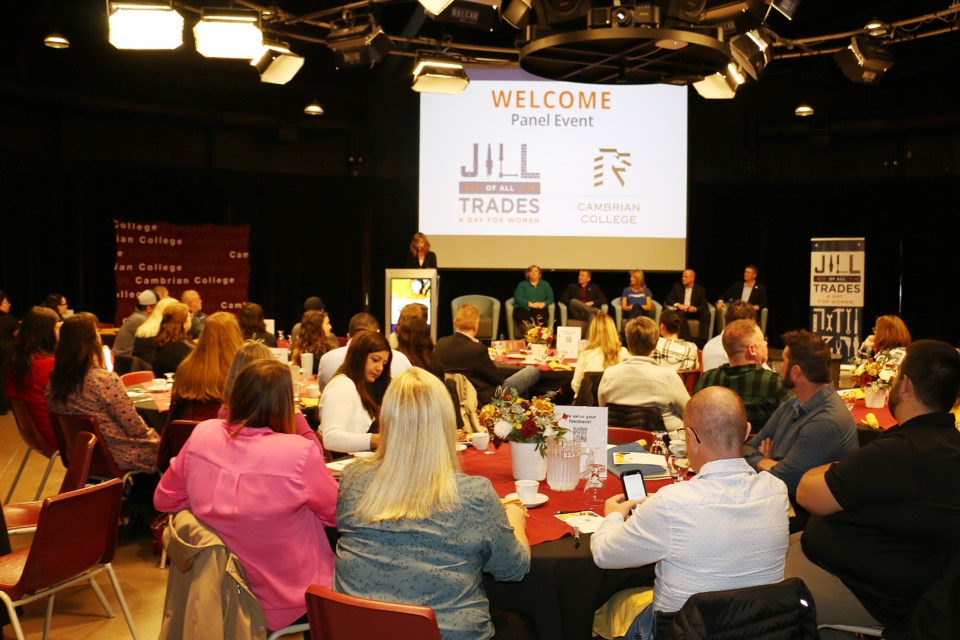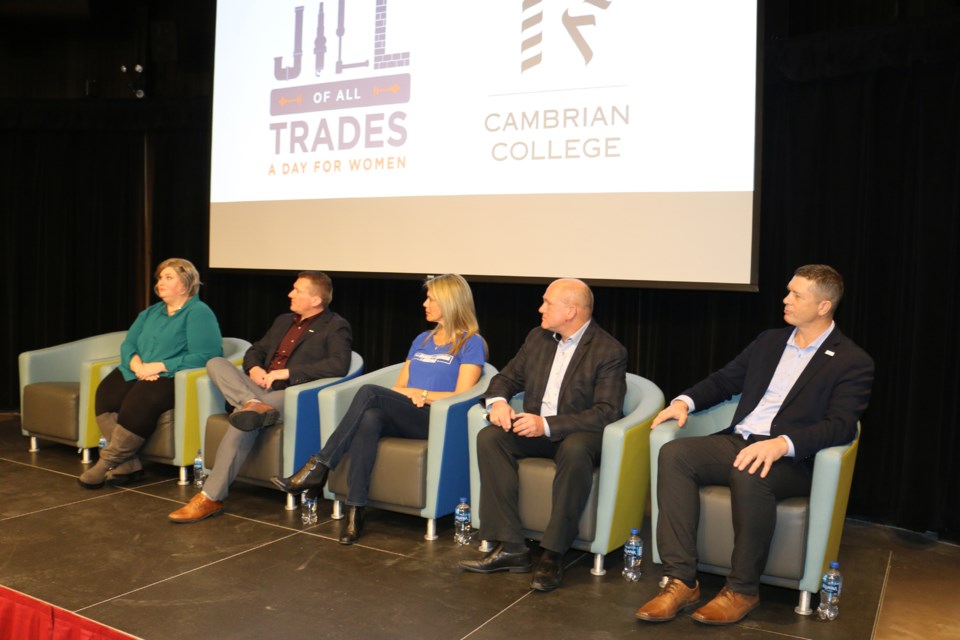When it comes to making male-populated workplaces more accessible and welcoming to women, Sudbury industrial leaders said change has been happening, but there is still room for improvement.
The concern was raised during the recent forum held at Cambrian College in Sudbury as part of the school's Jill Of All Trades event, aimed at encouraging more women to enter the trades field. The panel discussed why industry is working harder than ever to attract more females into the skilled trades.
Alison de Luisa, vice-president of human resources and student services at Cambrian College, emceed a panel discussion and asked the speakers what was being done to remove barriers for women seeking to enter the skilled trades.
Dale Rakochy, product line manager with Sandvik in Sudbury, said physical changes in the workplace can be more welcoming with things like new change rooms. But he said people still have to put aside old ideas that females were not welcome on the shop floor.
"I think there's a psychological barrier, which is the biggest challenge that we have to overcome. And this is with both sexes, actually," said Rokochy.
"There are now so many opportunities for females in the mining industry and in the trades force," he said, adding that a lot of older ideas about industrial work no longer apply.
"And they don't have to lift 50 pounds or 100 pounds … we don't even want our men to lift 50 pounds at work.”
Rokochy said he was hopeful the barriers would gradually disappear as more younger workers begin to populate the industrial workplace.
Julie Zulich, president and CEO of TESC Contracting Company, told the panel that some women face financial barriers in being able to access education and training.
Zulich said it was important for institutions such as Cambrian College to reach out and provide opportunities for financial aid.
"One of the things we need to do is we need to provide them with the opportunity to get seats around the table," said Zulich.
She said steps are being taken in the right direction, but it is not as easy as picking up the phone and asking for apprentices.
Zulich said when it comes to other barriers such as sexism and unconscious bias, then the approach is to talk about in the workplace, raise awareness and educate people.
She said another reason so many employers are open to hiring more women is because there is such an urgent demand for new workers, regardless of their gender. She said it is also a reason why so many older workers are being encouraged not to retire.
"There's so much work to do, and they need their expertise. So, you know, we really are, as an industry, kind of behind the eight-ball. And so it's really encouraging to hear what other companies are doing, and what we can do to move forward," said Zulich.
Another barrier that industry faces is that of retaining workers once they have been hired. Gord Gilpin, director of Ontario operations for Vale, said a key way to move forward on keeping female workers is through inclusivity.

Gilpin said it is important to provide a sense of welcome to female employees so they know right away they are part of a workplace where they are valued.
He cited the example of people invited out to the opening of a new mine where it was made clear that a new dry had been built for the female miners. A dry is where the miners change from street clothes to their mining clothes. One of Gilpin's colleagues was a woman who had been working in the mining industry for several years and had not seen a mine dry specifically dedicated for women.
"And she told me that after having been in the industry for so many years, when she first went through this brand new dry at the mine for her it was the first time that she actually walked through it," Gilpin recalled.
He said his colleague was so moved at seeing it brought a tear to her eye.
"And I'll tell you, when I hear that it's hard not to have a tear come to your eye because it actually really does mean a lot," said Gilpin. "So that's an example of inclusivity. And I think it's stories like that, that we need to be trying to extract right and share as leaders as much as we can.”
Another example he said is having properly fitted clothing for women (as Sudbury entrepreneur Alicia Woods has done with her Covergalls business).
"It's not rocket science, but it's so important and so impactful," said Gilpin. He said listening to people is also important. "Take the time to get groups of people sharing the challenges so that they go through after being attracted into the business and then being faced with, you know, some things that we still are not getting the mark on.”
Dustin Ceretti, mine director for Glencore in Sudbury, commented that along with overcoming barriers and biases, people simply have to be more accepting of women in the industrial workplace.
Ceretti related the example of a co-worker who mentioned to him that a 22-year-old female was seen driving a haul truck at the mine. Ceretti said he was surprised that people still consider that some sort of novelty.
"Can you imagine that? A 22-year-old female driving a haul truck? Why is that surprising? With technology nowadays, if they can drive a car, they can drive a haul truck? What's the difference? So it's still this paradigm that we have in our minds about young females operating heavy equipment? Like, why is that a stigma? Why is that still there?," Ceretti asked.
Joan Strawn, the health and safety co-ordinator at Damisona Roofing, said there are some systemic barriers that people might not normally consider because they're not immediately recognizable. She mentioned everyday work tools as an example.
"People don't necessarily realize that a lot of tools are not designed for women's hands, or physical body," said Strawn, adding that tools can be modified to make them easier and safer for women to use.
She said workplaces should also consider ensuring that PPE (personal protective equipment) is modified or accessable in sizes that can fit women properly.
Len Gillis covers mining and health care for Sudbury.com. Jobs of the Future is made possible by our Community Leaders Program.



